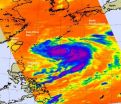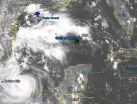(Press-News.org) Infrared satellite data from NASA's Aqua satellite revealed strong convection and a tight circulation center within Typhoon Fanapi as it heads for a landfall in Taiwan this weekend.
At 1500 UTC (10 a.m. EDT) on Sept. 17, Typhoon Fanapi's maximum sustained winds were near 85 knots (97 mph). It was centered about 360 nautical miles east-southeast of Taipei, Taiwan near 23.2 North and 127.4 East. It is churning up high seas up to 22 feet.
NASA's Aqua satellite passed over Typhoon Fanapi on September 17 at 04:45 UTC (12:45 a.m. EDT) and captured an infrared image of its cold cloudtop temperatures. The coldest cloud tops were as cold as -60F, and the imagery showed a tight center circulation at that time.
Infrared imagery today continues to show Fanapi consolidating. The typhoon is on the border of becoming a Category 2 typhoon on the Saffir-Simpson hurricane/typhoon scale. Infrared imagery also showed that Fanapi has an 11 mile-wide eye, and that there's a small gap in the eyewall in the northern part of the circulation. Because vertical wind shear is expected to increase over the next 12 to 24 hours, Fanapi is expected to weaken at that time.
Another instrument on NASA's Aqua satellite captured a visible image of Typhoon Fanapi. To see the image that the Moderate Resolution Imaging Spectroradiometer (MODIS) instrument captured of Typhoon Fanapi on September 17 at 04:45 UTC, go to: http://rapidfire.sci.gsfc.nasa.gov/gallery/?2010260-0917/Fanapi.A2010260.0445.
Fanapi is now moving northwest at 6 mph and is expected to make landfall on Sept. 19 during the morning hours local Asia/Taipei time (late Sept. 18 EDT). Fanapi is forecast to cross Taiwan from east to west and then emerge into the Taiwan Strait as a tropical storm and make a final landfall in eastern China on Sept. 20.
INFORMATION:
NASA eyes Typhoon Fanapi approaching Taiwan
2010-09-18
ELSE PRESS RELEASES FROM THIS DATE:
Tick tock: Rods help set internal clocks, biologist says
2010-09-18
We run our modern lives largely by the clock, from the alarms that startle us out of our slumbers and herald each new workday to the watches and clocks that remind us when it's time for meals, after-school pick-up and the like.
In addition to those ubiquitous timekeepers, though, we have internal "clocks" that are part of our biological machinery and which help set our circadian rhythms, regulating everything from our sleep-wake cycles to our appetites and hormone levels. Light coming into our brains via our eyes set those clocks, though no one is sure exactly how this ...
NASA's CloudSat satellite and GRIP Aircraft profile Hurricane Karl
2010-09-18
NASA's CloudSat satellite captured a profile of Hurricane Karl as it began making landfall in Mexico today. The satellite data revealed very high, icy cloud tops in Karl's powerful thunderstorms, and moderate to heavy rainfall from the storm. Meanwhile, NASA's "GRIP" mission was also underway as aircraft were gathering valuable data about Hurricane Karl as he moves inland.
NASA's Genesis and Rapid Intensification Processes mission (known as GRIP) is still underway and is studying the rapid intensification of storms, and that's exactly what Karl did on Thursday Sept. ...
NASA sees record-breaking Julia being affected by Igor
2010-09-18
Julia is waning in the eastern Atlantic Ocean because of outflow from massive Hurricane Igor, despite his distance far to the west. Satellite imagery from NASA's Aqua satellite showed that Julia's eye was no longer visible, a sign that she's weakening.
As NASA's Aqua satellite flew over Hurricane Julia from space on Sept. 16 at 1:35 p.m. EDT, the Moderate Resolution Imaging Spectroradiometer (MODIS) instrument captured a visible image of the storm. In the MODIS image, Julia's eye was no longer visible and its center was cloud-filled.
Although Julia is weakening from ...
Pickle spoilage bacteria may help environment
2010-09-18
Spoilage bacteria that can cause red coloration of pickles' skin during fermentation may actually help clean up dyes in textile industry wastewater, according to a U.S. Department of Agriculture (USDA) study.
Some species of Lactobacilli-food-related microorganisms-can cause red coloring when combined with tartrazine, a yellow food-coloring agent used in the manufacture of dill pickles. Now Agricultural Research Service (ARS) microbiologist Ilenys Pérez-Díaz and her colleagues have found that these spoilage Lactobacilli also may have environmental benefits. ARS is ...
Gene limits learning and memory in mice
2010-09-18
Deleting a certain gene in mice can make them smarter by unlocking a mysterious region of the brain considered to be relatively inflexible, scientists at Emory University School of Medicine have found.
Mice with a disabled RGS14 gene are able to remember objects they'd explored and learn to navigate mazes better than regular mice, suggesting that RGS14's presence limits some forms of learning and memory.
The results were published online this week in the Early Edition of the Proceedings of the National Academy of Sciences.
Since RGS14 appears to hold mice back mentally, ...
Research team assesses environmental impact of organic solar cells
2010-09-18
Solar energy could be a central alternative to petroleum-based energy production. However, current solar-cell technology often does not produce the same energy yield and is more expensive to mass-produce. In addition, information on the total effect of solar energy production on the environment is incomplete, experts say.
To better understand the energy and environmental benefits and detriments of solar power, a research team from Rochester Institute of Technology has conducted one of the first life-cycle assessments of organic solar cells. The study found that the embodied ...
Researchers at SUNY Downstate find drug combination may treat traumatic brain injury
2010-09-18
Traumatic brain injury (TBI) is a serious public health problem in the United States. Recent data show that approximately 1.7 million people sustain a traumatic brain injury annually. While the majority of TBIs are concussions or other mild forms, traumatic brain injuries contribute to a substantial number of deaths and cases of permanent disability.
Currently, there are no drugs available to treat TBI: a variety of single drugs have failed clinical trials, suggesting a possible role for drug combinations. Testing this hypothesis in an animal model, researchers at SUNY ...
Mechanism behind demethylation pinpointed in APC gene mutants
2010-09-18
Salt Lake City, September 17, 2010—Colon cancer is the second most common cancer in the United States and causes more than 50,000 deaths each year. It has been known for some time that mutations in the APC gene occur in more than 85 percent of all sporadic colon cancers. Now researchers at Huntsman Cancer Institute at the University of Utah demonstrate in a study featured today in Cell the mechanism by which mutation of the APC gene affects a cellular process known as DNA methylation. DNA methylation is a chemical modification made to DNA that plays an important role in ...
Great Lakes water quality is focus of new $5 million grant
2010-09-18
ANN ARBOR, Mich.---How could climate change and our response to it affect the Great Lakes' water quality? That's the primary question a team of 27 researchers from across the University of Michigan and collaborators at other institutions will answer with a new $5-million grant from the National Science Foundation.
The researchers will focus on extreme weather events caused by climate change.
The Great Lakes hold 84 percent of North America's surface fresh water, and their basin is home to 10 percent of the U.S. population.
"The suspicion is that climate change will ...
Aussie Chef Releases New Pizza Cookbook With Exciting Variations on Familiar Recipes
2010-09-18
Calling all cooks! You may think you know all there is to know about making pizza and chicken parmigiana, but Aussie chef Mick Reade has written a new cookbook that will creatively challenge your preconceived ideas about these two dishes. The 2001 winner of Australia's Best Steak Cooker title has now published a cookbook full of mouth watering variations on chicken parmigiana and pizza Recipes.
In his self published title, Pizzas and Parmas - The Possibilities Are Endless, Chef Reade shares some of the creative and unusual recipes he has used over the past 12 years as ...



